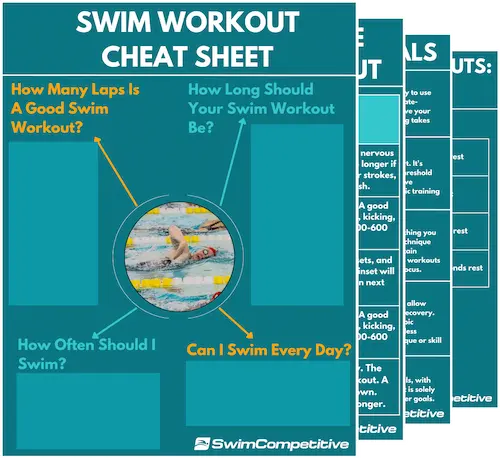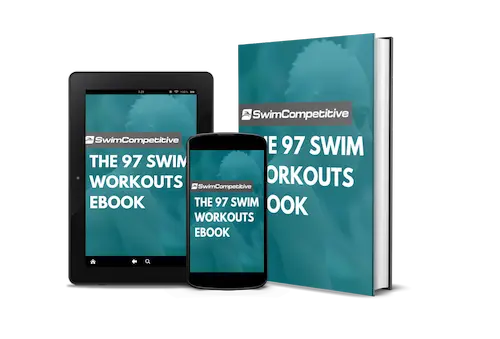Chances are you have probably heard about many of the benefits of swimming. Some of the popular ones include- a low impact workout, increased muscle mass, better aerobic fitness, endurance, and stamina as well as a highly effective way to burn calories and trim down on some body fat.
All of this sounds great but at the end of the day the question comes down to does swimming really build muscle? And how effective is it at doing this?
In today’s article, we’ll be taking a deeper look at all of the muscle-building properties that swimming has as well as which muscles swimming works and how you can maximize your muscle growth through swimming using 7 scientifically backed methods and guidelines.
Does Swimming Build Muscle?
The short answer is yes, swimming does build muscle. When swimming, you are constantly pushing and pulling against the resistance of the water involving a large number of muscle groups across your body. This ultimately creates the necessary environment for building muscle.
In case you didn’t know, muscle mass is built by applying resistance to a specific muscle group, or in many cases such as swimming, for example, applying resistance to a range of different muscle groups at the same time.
When the muscle is under enough stress it will create tiny tears in the fibers known as micro-tears. These tiny little tears in the muscle are usually the reason you’ll feel a sensation of soreness and fatigue the day, or in some cases, within a few hours after a good workout.
Muscles usually take around 24 to 48 hours to recover fully. Once muscles are fully recovered these micro-tears would have fully healed and repaired themselves resulting in muscle growth and an increase in strength and power.
This is confirmed by a meta-analysis published in the International Journal of Environmental Research and Public Health, involving one hundred and eleven studies, which found that resistance training increased muscle mass in trainees significantly.
At sea level, water is approximately 784 times denser than air, which also means that the resistance level of water is much much higher than that of air and it’s one of the main reasons why you’ll be able to build muscle through swimming.
As we just discussed, muscle is built by creating micro-tears in muscle fibers through resistance. Thus when you are swimming you are applying resistance to all of the involved muscle groups which will then create micro-tears in those muscles hence you are training at the right intensity resulting in muscle growth and an increase in strength once those muscles have recovered and rebuilt themselves.
Is Swimming Good For Building Muscle?
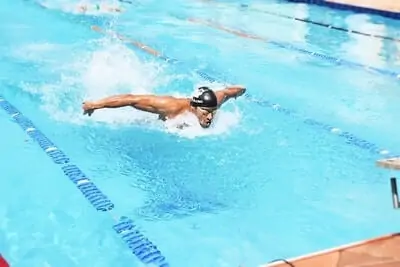
Swimming is a decent way to build muscle as water resistance is much higher than air resistance making swimming much more effective at building muscle than other cardio workouts. If you are, however, looking purely to build muscle, then you might want to try something like weight lifting.
As discussed in the section above, swimming can build muscle since the resistance of water is much higher than the resistance of air meaning that for the most part, you are also going to build more muscle through swimming than with standard forms of cardio like walking, running, or cycling.
The real question, however, is how effective is swimming for building muscle really? As also discussed earlier in this article, the muscle gets built after micro-tears in that muscle, created by an external force, recover.
The problem, however, is that after a few times of applying this external force or resistance to the muscle, it would have adapted and become stronger and bigger meaning now you’ll require a larger force or resistance to then again stimulate the muscle, causing micro-tears, which will then allow for muscle growth once the muscle is again rebuilt.
This means that building muscle is a constant process of applying resistance, stimulating the muscle, and then giving it a chance to recover and grow to become stronger and bigger. It also means that as time passes you’ll have to constantly increase resistance to keep the muscle-building process going.
With training methods such as lifting weights, this is very straight forward and also why these types of workouts are so effective at building muscle. Once you have completed the same workout 1 or 2 times you simply add a pound or two onto the bar- and bam resistance is increased and you are effectively able to build muscle again.
With swimming, things are unfortunately not so simple and straight forward. Increasing resistance in the water is still definitely possible and so is continuous muscle growth over many many months and years, but the process of increasing the resistance is a bit more complicated.
This doesn’t mean swimming is bad for building muscle, it simply means that a little more brainpower and planning are going to be required to avoid plateauing when it comes to building muscle in the water.
So if you are willing to give swimming a shot, and in doing so reap all of the other hundreds of benefits it holds, then stick around, because later in this article I’ll show you some effective ways you can continually maximize your muscle growth through swimming and I’ll also give you some swimming workouts designed specifically for this purpose.
What Muscles Does Swimming Work?

Swimming works almost every muscle in your body while different strokes place a higher emphasis on certain muscle groups. Some of the most worked muscles in swimming include the core, lats, shoulders, pecs, and triceps in the upper body and the glutes, hamstrings, quads, and calves in the lower body.
Although not every muscle is worked exactly equally I can’t think of a single muscle that isn’t involved when swimming. This means that swimming is a highly time-effective way to not only train every muscle group in your body, but also to develop good cardiovascular fitness, and burn some calories to keep your body in good condition.
Here is a list of every major muscle group swimming works and how those muscles get worked-
Core: The abdominal muscles are constantly working as you swim, helping to stabilize your entire body to maintain a good body position. They are also highly involved when doing underwater dolphin kicks and play an important role in your turns by creating a contracting motion like a crunch for example.
If you are an experienced swimmer you may want to do some additional core training, for this consider checking out my article on the best core exercises for swimmers.
Upper Back: Whether you are swimming freestyle, backstroke, butterfly, or breaststroke, the upper back is always going to be involved. Muscle groups like the lats and traps play an important role in the pulling motion of your stroke and also help you to maintain a good streamline position.
Lower Back: The lower back is one of the few muscle groups that gets neglected by swimming. That said, it still gets used quite a bit. The lower back along with the core and glutes is going to help to bring your legs up during the upward motion of your kicks and underwater dolphin kicks.
Shoulders: The shoulders has to be one of the most worked muscles in swimming. It is constantly rotating and flexing in various directions to help you pull and push water to create propulsion. This is why hardcore competitive swimmers often get shoulder injuries since this muscle gets worked so much!
Chest: Believe it or not, but the chest gets used quite a lot when swimming, especially in butterfly and breaststroke. The pectoral muscles assist the arms in pushing water through underneath your body when you pull as well as pushing it past the sides of your body on backstroke.
Triceps: The triceps are constantly contracting and flexing as you swim, creating very similar movement patterns compared to exercises like tricep extensions.
Biceps: Similar to the triceps the biceps also get used during the pulling motion as you swim. These muscles don’t get used quite as much as the triceps, but play a big role in strokes like butterfly and breaststroke.
Quads: Did you know that the legs can generate upwards of 33% of the speed when sprinting freestyle? This means that the lower body muscles, such as the quads here, for example, play a big role in swimming and have high involvement.
The quads are working non-stop as you are swimming, helping to push water down along with the hip flexors creating propulsion to move you forward in the water.
Glutes: Opposite to the quads, the glutes help to pull your legs up towards the surface of the water creating a powerful upward motion in your kick.
Hamstrings: This muscle group works alongside your glutes to create the upward motion in your kick in strokes like freestyle and butterfly, the downward motion of your kick in backstroke, and a very intense leg flexion mechanic in breaststroke.
Calves: These muscles are constantly contracted as you swim. When swimming your toes should be pointed forward to create effective propulsion in the water, this is going to involve the calves. These muscles are also active when pushing off from the wall after a turn.
Related: How does swimming change your body?
How To Build Muscle Swimming
Here are 7 tips for effectively building muscle swimming-
- Eat correctly and consume enough protein.
- Swim at least 2 times per week.
- Use equipment to add resistance when swimming.
- Isolate specific muscles when swimming.
- Create metabolic stress to maximize muscle growth.
- Mix up and intensify your swimming workouts.
- Incorporate dryland strength training.
1. Optimize Your Nutrition

Good nutrition is one of the most fundamental parts of effectively building muscle through swimming and any other exercise for that matter. If you aren’t providing your body with the required energy and building blocks to recover after working out, how is it supposed to rebuild the micro-tears in your muscles created by that training in the first place?
A study published by the Journal of the International Society Of Sports Nutrition found evidence that a minimum of 1.6 grams of protein per kilogram of body weight (0,7 grams per pound) is required for effectively maximizing muscle anabolism, with the upper limit being around 2.2 grams per kilogram of body weight (1 gram per pound).
The study also found that it was best to spread out protein consumption across a minimum of 4 meals per day containing 0.4 grams protein/ kg/ meal to reach the minimum intake of 1.6 grams of protein/ kg body weight/ day with a maximum of 0.55 grams protein/ kg/ meal to reach the maximal intake of 2.2 grams protein/ kg body weight/ day.
For most swimmers, I recommend using a whey protein supplement, this is just going to ensure that you reach your optimal protein intake every day, ultimately maximizing your recovery and muscle growth.
Apart from protein, in order for your body to build muscle at the most efficient rate, you should be consuming a surplus amount of energy (aka calories or kilojoules) from the food you eat. This is covered in extreme detail in my meal plan for swimmers article.
But to keep things simple, a surplus energy means that you are consuming more calories in a day than you are burning, meaning you’ll gain weight. This weight will consist both of muscle mass as well as a little bit of fat which is simply part of the process, you can shed this off later.
Swim at Least 2 Times Per Week
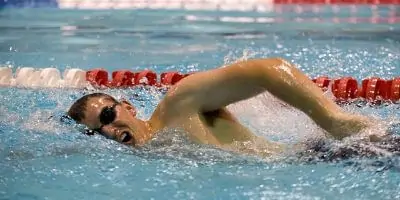
Once you have your nutrition under control we can get to the training side of things.
The first aspect of maximizing your muscle growth in the water is going to be training frequency.
A meta-analysis published by researchers Brad J. Schoenfeld, Dan Ogborn, and James W. Krieger found that training frequencies of at least twice per week per muscle group seemed to show the highest rate of muscle growth. At the same time, it is uncertain whether or not a frequency of 3 times per week would be more optimal.
That said, the analysis did indicate that a higher training frequency tended to show greater muscle building effects meaning that training more than 2 times per week may actually increase growth even further hence you’re eating and recovering properly outside of the water.
Considering we are working with swimming here as our resistance training method, I’d say that a training frequency of more than 2 times a week is definitely going to be more beneficial for maximizing your muscle growth since swimming is very low impact and isn’t as damaging to the muscle as something like lifting weights.
For those under a time constraint, however, 2 times per week will still be adequate.
Do You Want to Make Every Lap Count?
Stop wasting your time in the pool feeling lost and doing directionless swim workouts, and start training effectively! Our ebook contains 97 structured and goal-orientated swim workouts to help you become a better, faster, and fitter swimmer. Whether you’re a complete beginner or a seasoned pro, there are a multitude of workouts for every type of swimmer.
3. Swim with Resistance Training Equipment
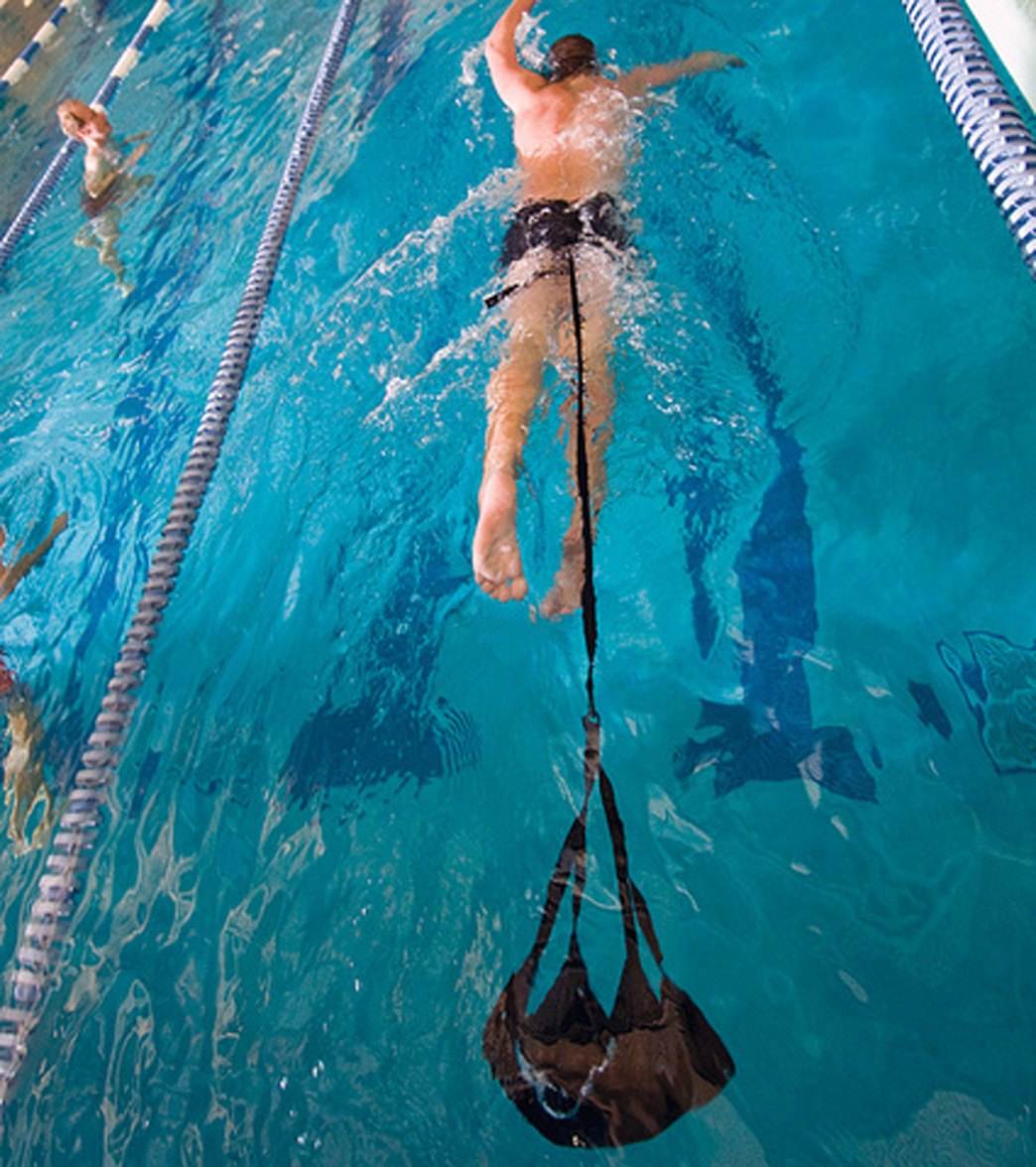
A study published in the Journal of Sports Science & Medicine found that male college students were able to significantly increase muscle mass after 8 weeks of resistance training. The study mainly used upper body training exercises such as shoulder press, bench press, lat pull-downs, dips, crunches, and various arm exercises for its investigation.
That said, as you should know by now these exercises alone aren’t necessarily the driving factor behind muscle growth, but rather the resistance created by them. This resistance can be recreated using various movement patterns and strokes in swimming, meaning that swimming can also serve as a resistance training workout.
As you also know to become stronger and consistently build muscle you need to progressively increase resistance in the water. This can be done in various ways as we are going to be discussing in the following sections.
Our first way of increasing resistance in the water is going to involve utilizing resistance swimming equipment.
There are various pieces of swimming equipment that we can use to add resistance to our training. Some options include- fins, paddles, drag suits, resistance parachutes, ankle and wrist weights, and resistance gloves.
If you are interested you can check out some of this swimming resistance equipment on SwimOutlet by clicking here to take your swimming workouts to the next level.
If you have a swimming power rack or weight pulley set available to you at your pool that will also be a great way to add resistance to your training throughout your swimming workouts.
And let me just clarify, I’m not saying you should use resistance swimming equipment on every set you do, rather incorporate it throughout your swimming workouts as appropriate to ensure muscle development while still becoming a better swimmer through focusing on technique, body position, and so on.
4. Isolate Muscle Groups While Swimming
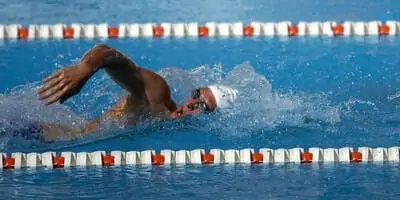
Our next point builds on the idea of increasing the resistance in the water. This time we’ll be taking a look at isolating certain muscle groups in order to achieve a greater resistance load on the involved muscles which should then promote muscle growth.
The simplest way to achieve this is by breaking muscle groups up into 2 parts namely the upper body and lower body.
The upper body only can be separately trained by removing the kick from your stroke. For this you can also use equipment such as a pull-buoy or paddles or you can even use both pieces at the same time.
In the same light, the lower body can also then be separated and effectively be trained by removing the pulling mechanics from your stroke. You can do body position kicking or you can use a kickboard when doing leg only sets. You can also slap on a pair of swimming fins to really ramp up the intensity.
Another way to emphasize certain muscle groups over others is by using swimming drills such as the 1-arm drill for example. By utilizing the 1-arm drill you are placing most of the upper body work on a single-arm, meaning that arm has to work harder in order to pull you forward in the water.
5. Create Metabolic Stress When Swimming

Research such as this study published by the Journal Of Applied Physiology has shown that metabolic stress on the body helps to increase the effectiveness of resistance training in the process of muscle building.
This study in particular looked at the effects of metabolic stress on building muscle while utilizing low-intensity resistance exercises and found that it was effectively able to aid in increasing muscle mass when combined.
This means that swimming alone, generally classified lower in the ranks of resistance training, can be used to effectively increase muscle mass when combined with optimal levels of metabolic stress.
What’s great about swimming is the fact that creating metabolic stress through it isn’t too hard. Metabolic stress is usually created by high-intensity training while hypoxia (lack of oxygen) also aids in creating metabolic stress. This means that swimming can be used to create an ideal environment for metabolic stress by utilizing high intensity- and hypoxic sets.
Long-distance swimming alone, commonly used by many non-competitive swimmers, isn’t enough nor is it ideal for creating metabolic stress.
Some good example sets that create metabolic stress include-
- 10x100s freestyle on 1:30 breathing every 4 to 6 strokes.
- 16x50s choice stroke, max intensity on 1:00.
- 16x25s freestyle or butterfly sprints, only breathing 3 times for the length on 0:40.
- 10x200s freestyle on 3:00.
Please note that the sets given above are quite intense and if you aren’t a competitive swimmer you are probably not going to be able to make the intervals or effectively execute the set.
This doesn’t mean you can’t incorporate this style of training into your workouts. It simply means that you should either adjust the sets above so that you can make them with them still being very intense or you should create your own similar sets that you are able to complete.
6. Mix Up and Intensify Your Swimming Workouts
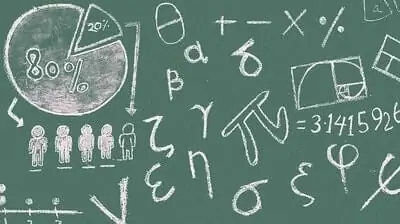
As you have probably figured out by now- doing the same swimming workout over and over again most likely isn’t going to be the most beneficial for creating muscle growth through swimming.
Sure, you can definitely do the same workout two to three times but anything more than that is going to be a waste of your time.
Throughout the last few points, we have looked at various ways that you can increase the resistance on muscles by utilizing different training techniques. In this section, we will be taking a look at how you can adjust your workouts to be more intense as you become a more experienced and stronger swimmer.
Most beginner swimmers should be able to build muscle through the resistance of the water alone during their first month or two of swimming. After that, you can start including the above-described training methods and techniques.
During the period of starting out swimming as well as for those who have a lot of experience, you are going to want to change up and intensify workouts.
This can be done through a couple of techniques such as-
- Increasing swimming distance per workout.
- Decreasing rest periods.
- Swimming on timed intervals.
- Incorporating hypoxic sets.
- Incorporating lactate intolerance sets.
7. Incorporate Dryland Strength Training
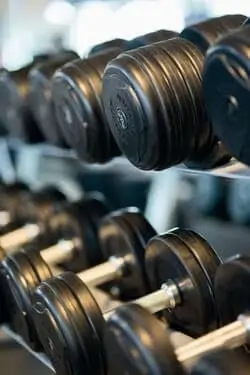
The final training technique is recommended for experienced swimmers who feel that they have almost maximized the amount of muscle that they can build in the water alone or who feel that they have reached a plateau in terms of muscle building progress in the pool for whatever reason.
A study published by the Journal of Sports Science & Medicine found that a combined dry-land strength and aerobic training program showed positive effects of increased strength and enhanced swimming performance in young competitive swimmers after 8 weeks of training.
Dryland strength training is a form of cross-training aimed at strengthening muscle groups used in swimming. This naturally means that resistance outside of the water will be applied to that muscle in order to force it to grow and become stronger.
Dryland strength training can have many forms, some of the popular options among swimmers include-
- Lifting weights.
- Bodyweight training (calisthenics).
- Resistance band training.
- Pilates.
- Or a combination of them.
3 Swimming Workouts to Build Muscle
Beginner:
- Warm-up: 300 easy choice swimming, 200 choice swimming drills.
- Main-set: 10x100s freestyle, 10 seconds rest, use fins and paddles on 5 of the 100s.
- Post-set: 12x25s on 1:00 max sprint, choice stroke.
- Cooldown: 200 easy backstroke swimming.
- Total: 2000 meters/ yards.
Intermediate:
- Warm-up: 400 easy choice swimming.
- Pre-set: 5x100s kicking with fins and kickboard, 20 seconds rest.
- Main-set: 5 rounds 4x50s IM order swimming on 1:00 building up speed through the 50, 200 easy freestyle breathing every 4 between rounds.
- Cooldown: 200 easy choice swimming.
- Total: 3100 meters/ yards.
Advanced:
- Warm-up: 500 easy choice swimming breathing every 4.
- Pre-set: 12x50s IM order building speed throughout while using a piece of resistance equipment (drag suit, resistance parachute, wrist weights, etc.), 15 seconds rest.
- Main-set: 5 rounds 4x100s freestyle on 1:30, no equipment; 100 choice drills in between rounds.
- Post-set: 10x25s underwater with fins on 0:45.
- Cooldown: 300 easy choice swimming.
- Total: 4150 meters/ yards
Swimming Can Build Muscle– but Is It for You?
Swimming may not 100% be the most effective way of building muscle, but it can certainly still help you to pack on muscle mass if you stay consistent with your training in the water and apply the tips and guidelines given in this article.
That said, considering all of the other health benefits that come along with spending some time in the pool, I’d say, and many experts in the field will agree with me here, that swimming is a far more effective way to spend your time working out when compared to many other forms of exercise– yet at the end of the day it will depend on your goals and what you want.
